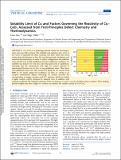| dc.contributor.author | Sun, Lixin | |
| dc.contributor.author | Yildiz, Bilge | |
| dc.date.accessioned | 2020-03-27T13:48:26Z | |
| dc.date.available | 2020-03-27T13:48:26Z | |
| dc.date.issued | 2018-12 | |
| dc.date.submitted | 2018-08 | |
| dc.identifier.issn | 1932-7455 | |
| dc.identifier.uri | https://hdl.handle.net/1721.1/124376 | |
| dc.description.abstract | Cu-CeO[subscript 2] is a promising material system for low-temperature water gas shift reactions. The solubility and oxidation state of Cu in Cu-CeO[subscript 2] is important for these reactions, but these values have been unclear from the literature to date. We used first-principle calculations and statistical thermodynamics to assess Cu defect configurations and oxidation states in bulk ceria, at both equilibrium and non-equilibrium conditions. Cu solubility was found to be very low, lower than ppm level at equilibrium, indicating that the nanoparticles with high Cu content reported in experimental literature are, in fact, in non-equilibrium states. Thus, these non-equilibrium states were also assessed by fixing the Cu content from 0.001 to 1%. Under oxygen-rich conditions, Cu takes 3+, serving as an acceptor substitutional dopant. Increasing Cu content increases the concentrations of oxygen vacancies and Ce[superscript 3+] polarons, which can induce a higher catalytic activity compared to undoped ceria. In addition, with reducing conditions, the oxidation/reduction of the Cu between 1+ and 2+ can also facilitate surface reactions. These findings provide insights into why a higher Cu content can enhance the catalytic activity in Cu-CeO[subscript 2] . | en_US |
| dc.description.sponsorship | United States. Department of Energy. Office of Basic Energy Sciences (Grant DE-SC0002633) | en_US |
| dc.description.sponsorship | National Science Foundation (U.S.) (Grant TGDMR120025) | en_US |
| dc.language.iso | en | |
| dc.publisher | American Chemical Society (ACS) | en_US |
| dc.relation.isversionof | 10.1021/ACS.JPCC.8B08222 | en_US |
| dc.rights | Article is made available in accordance with the publisher's policy and may be subject to US copyright law. Please refer to the publisher's site for terms of use. | en_US |
| dc.source | MIT web domain | en_US |
| dc.title | Solubility Limit of Cu and Factors Governing the Reactivity of Cu–CeO[subscript 2] Assessed from First-Principles Defect Chemistry and Thermodynamics | en_US |
| dc.type | Article | en_US |
| dc.identifier.citation | Sun, Lixin, and Bilge Yildiz. “Solubility Limit of Cu and Factors Governing the Reactivity of Cu–CeO[subscript 2] Assessed from First-Principles Defect Chemistry and Thermodynamics.” The Journal of Physical Chemistry C 123, 1, (January 2019): 99–409. | en_US |
| dc.contributor.department | Massachusetts Institute of Technology. Department of Materials Science and Engineering | en_US |
| dc.contributor.department | Massachusetts Institute of Technology. Department of Nuclear Science and Engineering | en_US |
| dc.relation.journal | Journal of Physical Chemistry C | en_US |
| dc.eprint.version | Author's final manuscript | en_US |
| dc.type.uri | http://purl.org/eprint/type/JournalArticle | en_US |
| eprint.status | http://purl.org/eprint/status/PeerReviewed | en_US |
| dc.date.updated | 2020-02-27T15:58:09Z | |
| dspace.date.submission | 2020-02-27T15:58:11Z | |
| mit.journal.volume | 123 | en_US |
| mit.journal.issue | 1 | en_US |
| mit.license | PUBLISHER_POLICY | |
| mit.metadata.status | Complete | |
